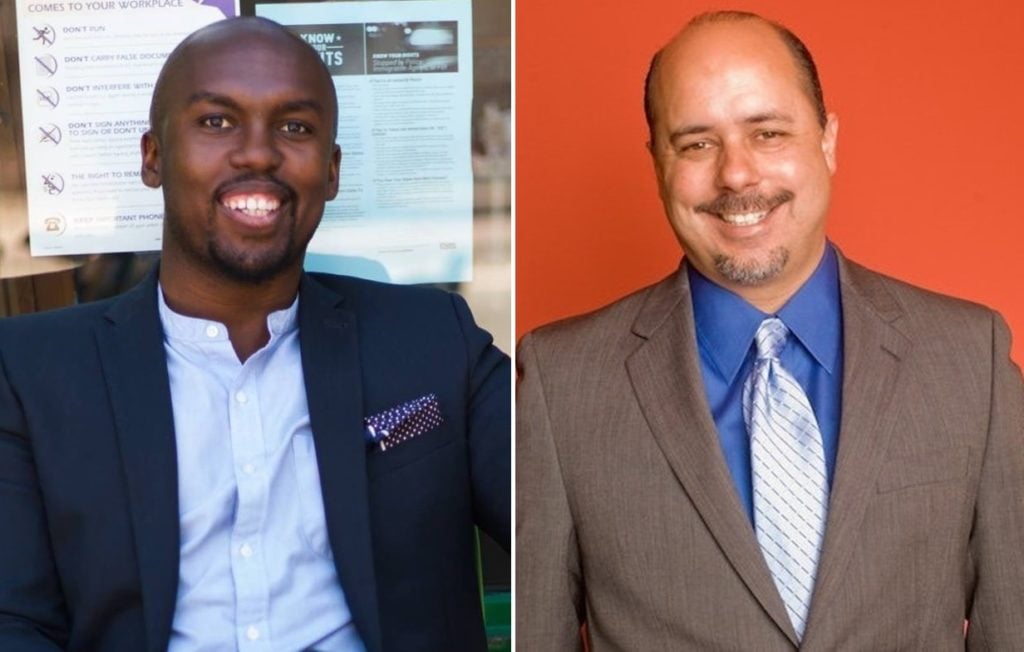Opinion
San Francisco School Board Execs on Why Criticism of Their Plan to Erase the George Washington Slave Mural Is ‘Malarky’
The president and vice president of the board reply to Bari Weiss's op-ed in the New York Times.

The president and vice president of the board reply to Bari Weiss's op-ed in the New York Times.

Stevon Cook &
Mark Sanchez

The following is a letter originally written as a response to the June 28 New York Times op-ed by Bari Weiss, “San Francisco Will Spend $600,000 to Erase History,” by two members of the San Francisco School Board who voted to paint over Victor Arnautoff’s murals, The Life of George Washington, at George Washington High School. A truncated version was published in the Times letter section on July 12. The complete original letter is published here with permission of the authors.
One of the retrograde implications made in Bari Weiss’s New York Times opinion piece, “San Francisco Will Spend $600,000 to Erase History,” is that the city’s board of education’s unanimous vote to paint down Washington High School’s mural is wrong because there’s a perceived majority of the public who are against doing so. The preponderance of email we’ve received at this time, indeed, speaks to the desire to keep the mural as is. However, for decades thousands of students as well as adult members of the African American and Native American communities have implored the school district to remove the mural because it causes real deleterious harm to them.
Who to listen to, then, especially when those in favor of keeping the mural are predominantly of European descent, and those protesting the mural are overwhelmingly people of color? Should this critical issue be decided upon as though it was some sort of popularity contest? That’s what Weiss signals when she notes that four Washington High freshmen agreed while 45 disagreed with the removal of the mural after being asked to write about the controversy as a class assignment. Ultimately, our school board came down on the side of communities that we all know have had their priorities ignored when it comes to just about anything, historically or presently, and certainly not regarding how they are depicted in centuries past public works of art. The school board decided that amplification of voices who have all too often been silenced was the course to go, with confidence that the decision will land on the right side of history.
None of the people quoted in Weiss’s piece were identified as Native American or African American (just as none were consulted by the artist when planning his mural in 1936). Her piece clearly disregards their voices; not one is quoted. Splinter’s Nick Martin finds this to be a pattern: “After searching extensively through her archive, I could not locate a single piece that Bari Weiss had written about Indigenous people since starting at the New York Times. Nor could I find any pieces of hers providing a platform to any Indigenous voices at any of her prior stops.” Weiss certainly is free to opine the way she does, but to exclude the views of those who formed the bulwark of resistance to how the dominant culture illustrates their lives and legacies is more than unfortunate, it also perpetuates in mainstream media the wholesale invisibility of communities who are continually forced to fight desperately for equal rights, freedoms, and representation.
Our school board, like all school boards, is charged first and foremost with ensuring the well-being of all our students, academically and socio-emotionally, particularly those who have been historically marginalized by our society. When one ignores the heart of the issue that’s driven a decades-long battle to repair harm, as Weiss does, it becomes easy to trot out the tired trope of a feckless bureaucratic board reflexively deciding to spend a lot of money to censor an artist, who as it turns out, becomes the real victim in the author’s view. She dismisses the board’s decision, saying members (who, save one, are all people of color) feared losing reputation and being equated as white supremacists if they didn’t vote to remove the mural. Given that upside-down logic, it’s no wonder the focus of Weiss’s commentary is censorship, leaving little space for what the board was actually grappling with: Should an immovable, public school-located piece of art that for more than 80 years has traumatized students be allowed to remain? Weiss says yes. When one makes their way to the end of her commentary it’s not shocking in the least to find that she makes a false equivalency argument about students potentially being triggered by viewing photos of the My Lai massacre. Malarkey.
Although we are disappointed, we are not surprised by the stance taken by Weiss under the imprimatur of the New York Times. Moving forward, we hope for a more balanced approach in response to such nuanced issues.
Stevon Cook, President, San Francisco Board of Education
Mark Sanchez, Vice President, San Francisco Board of Education